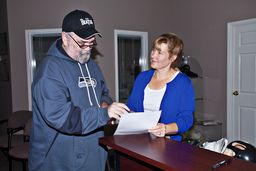FAQ
Frequently Asked Questions

No. The foot orthoses should not create new pain or aggravate existing pain. There is always an adjustment, or transition period for anything that one puts on their body to restrain movement, however, there should be NO PAIN associated with this transition period, only an unfamiliar and therefore, for some, an uncomfortable new feeling to get used to. The mind is an amazing tool and helps us to quickly adapt to new things, this transition period should only last for a few days. If you feel any increased or new pain, or if you have any concerns or questions, you should contact your Certified Orthotist for an appointment. If the orthoses do cause pain – DO NOT WEAR THEM.
The first step to make in arranging for a brace is to Make an Appointment. The Certified Orthotist will assess you to determine the most appropriate course of action. We will outline a plan that works for you.
In general the steps are:
- assessment and development of a treatment plan
- cast and measure
- you go home and then over 1-2 weeks, we make the brace in our lab
- you return and we try the brace and fine tune it
- we re-evaluate the comfort and function
- you return for follow up as needed
Custom made foot orthoses (FOs) are made specifically for an individual based on the unique medical and biomechanical requirements of the person. The ready-made insoles that are found at many different stores are made to fit everyone and are sized according to shoe size. They do not take into consideration the different foot shapes and anatomy, but are made to try and fit everyone. In some cases the ready-made insoles work well and serve an important purpose. For many people however, the unique issues that are creating problems can only be solved by a pair of custom made foot orthoses. If you have foot or leg problems, see your doctor for a proper diagnosis. Then, schedule an appointment with us and we can assess your individual needs and make a recommendation that is right for you – sometimes that recommendation includes ready made insoles or sometimes custom made foot orthoses but sometimes no intervention at all!
In some cases there is funding for Orthotic Devices. Some insurance policies (Employee Benefits) may provide funding or partial funding. Please check your personal policy as each policy is unique. We are agents with the Workplace Safety and Insurance Board (WSIB), Non-Insured Health Benefit (NIHB), Greenshield and other funding groups. For a selected group of orthoses, The Ministry of Health Assistive Devices Program (ADP) may provide partial funding for long term devices. Click here for answers from the Ontario Ministry of Health and Long-Term Care.
In any case we will provide you with all paperwork that you need and help guide you through the process.
When you come for your first appointment, make sure you bring any information that is relevant to the reason for the appointment.
You should bring:
- any notes from other health care professionals such as your doctor, physiotherapist, occupational therapist, chiropractor, chiropodist
- any test results that you may have
- if the appointment is regarding your feet or legs, bring the shoes you most commonly wear
- any devices that you may have worn in the past (previous foot orthoses or braces)
- if the appointment is regarding your legs or knees, bring shorts
- make sure that you know your insurance information
- your schedule in the case that you need to book another appointment
- any other information that you think may help us do our job better
If you do have questions before your appointment, just call or email us, we are happy to help!


